“On Earth, life likes chemical diversity – the more diversity, the better. We’re carbon-based life. Understanding the chemistry of Europa’s ocean will help us determine whether it’s hostile to life as we know it, or if it might be a good place for life,” said Geronimo Villanueva of NASA’s Goddard Space Flight Center in Greenbelt, Maryland, lead author of one of two independent papers describing the findings.
“We now think that we have observational evidence that the carbon we see on Europa’s surface came from the ocean. That's not a trivial thing. Carbon is a biologically essential element,” added Samantha Trumbo of Cornell University in Ithaca, New York, lead author of the second paper analyzing these data.
Webb finds that on Europa’s surface, carbon dioxide is most abundant in a region called Tara Regio – a geologically young area of generally resurfaced terrain known as “chaos terrain.” The surface ice has been disrupted, and there likely has been an exchange of material between the subsurface ocean and the icy surface.
“Previous observations from the Hubble Space Telescope show evidence for ocean-derived salt in Tara Regio,” explained Trumbo. “Now we’re seeing that carbon dioxide is heavily concentrated there as well. We think this implies that the carbon probably has its ultimate origin in the internal ocean.”
“Scientists are debating how much Europa’s ocean connects to its surface. I think that question has been a big driver of Europa exploration,” said Villanueva. “This suggests that we may be able to learn some basic things about the ocean’s composition even before we drill through the ice to get the full picture.”
Carbon dioxide isn’t stable on Europa’s surface. Therefore, the scientists say it’s likely that it was supplied on a geologically recent timescale – a conclusion bolstered by its concentration in a region of young terrain.
“These observations only took a few minutes of the observatory’s time,” said Heidi Hammel of the Association of Universities for Research in Astronomy, a Webb interdisciplinary scientist leading Webb’s Cycle 1 Guaranteed Time Observations of the solar system. “Even with this short period of time, we were able to do really big science. This work gives a first hint of all the amazing solar system science we’ll be able to do with Webb.”
NIRCam (the Near Infrared Camera) on NASA’s James Webb Space Telescope captured this picture of the surface of Jupiter’s moon Europa. Webb identified carbon dioxide on the icy surface of Europa that likely originated in the moon’s subsurface ocean.
Credits: Science Credit: Geronimo Villanueva (NASA/GSFC), Samantha Trumbo (Cornell Univ.), NASA, ESA, CSA. Image Processing Credit: Geronimo Villanueva (NASA/GSFC), Alyssa Pagan (STScI
Searching for a Plume
Villanueva’s team also looked for evidence of a plume of water vapor erupting from Europa’s surface. Researchers using NASA’s Hubble Space Telescope reported tentative detections of plumes in 2013, 2016, and 2017. However, finding definitive proof has been difficult.
The new Webb data shows no evidence of plume activity, which allowed Villanueva’s team to set a strict upper limit on the rate of material potentially being ejected. The team stressed, however, that their non-detection does not rule out a plume.
“There is always a possibility that these plumes are variable and that you can only see them at certain times. All we can say with 100% confidence is that we did not detect a plume at Europa when we made these observations with Webb,” said Hammel.
These findings may help inform NASA’s Europa Clipper mission, as well as ESA’s (European Space Agency’s) upcoming Jupiter Icy Moons Explorer (JUICE).
Quelle: NASA
----
Update: 27.09.2023
.
James Webb Space Telescope sees early galaxies defying 'cosmic rulebook' of star formation
"It was like the galaxies had a rulebook that they followed — but astonishingly, this cosmic rulebook appears to have undergone a dramatic rewrite during the universe’s infancy."
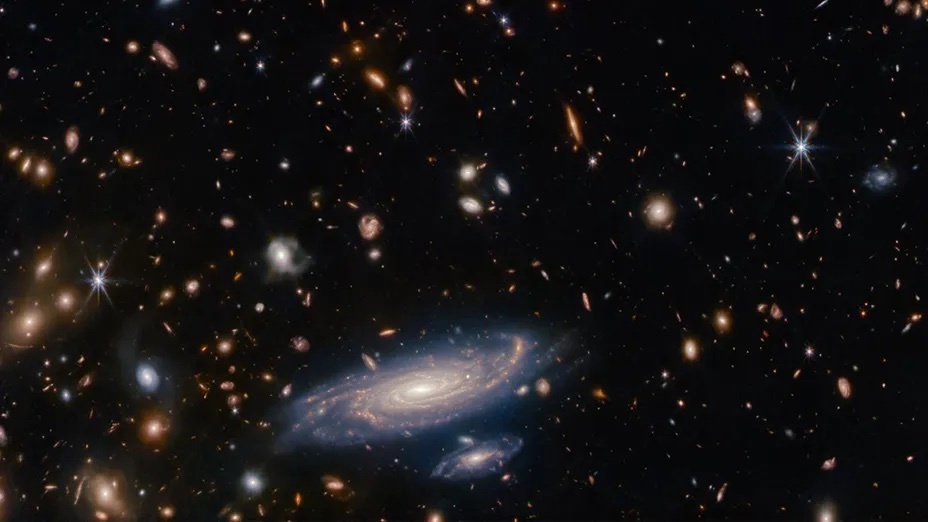
Rule-breaking galaxies in the early universe as seen by the James Webb Space Telescope. (Image credit: NASA/ESA/JWST)
The James Webb Space Telescope (JWST) has discovered that galaxies in the early universe were cosmic rule-breakers. This discovery sheds light on how early galaxies evolved and the fundamental processes that shaped the universe as we see it today.
To discover the truth about these cosmic scofflaws, a team of astronomers used the JWST to gaze over 12 billion years back in time and observe galaxies as well as the rules they followed through cosmic history. The crew found that the same set of rules continuously prevailed, connecting the rate of star birth to galactic masses to chemical compositions. But these rules traced only so far back. The earliest galaxies defied them.
It was like the galaxies had a rulebook that they followed — but astonishingly, this cosmic rulebook appears to have undergone a dramatic rewrite during the universe’s infancy," Claudia Lagos, an associate professor at the University of Western Australia, said in a statement. "The most surprising discovery was that ancient galaxies produced far fewer heavy elements than we would have predicted based on what we know from galaxies that formed later."
This disparity hadn’t been spotted before because instruments used prior to the JWST hadn’t been powerful enough to see the chemical makeup of galaxies as far back as around 11 billion years ago. The JWST, however, allowed this team to look back to just a few hundred million years after the Big Bang, which showed a break in the relationship between star formation, mass and chemistry.
When did things get heavy for the cosmos?
When the universe first began to form the first stars and galaxies, it was filled with hydrogen and helium — the two lightest elements — with the former being the most dominant by far.
Only a smattering of heavier elements-which astronomers call “metals” existed until the first generation of stars forged them at their hearts and then dispersed them through the universe at the end of their lives via massive supernovaexplosions.
This material was eventually incorporated into the next generation of stars, meaning these stars, and thus the galaxies they sit in, had a higher concentration of metals — a measure called "metallicity." That process of metal enrichment has continued throughout the entire 13.8 billion years of cosmic history, meaning early galaxies are indeed expected to have lower metallicities than their modern counterparts.
But even factoring this in, the team found that the metallicity of early galaxies was still lower than expected. Much lower.
"Their chemical abundance was approximately four times lower than anticipated, based on the fundamental-metallicity relation observed in later galaxies," Lagos continued, explaining that the early galaxies observed by the team delivered even more surprises.
The team suggests the disparity may exist because galaxies just a few hundred million years after the Big Bang could still be intimately connected with the intergalactic medium — the wispy hot gas and dust that exists between galaxies.
"The early galaxies continually received new, pristine gas from their surroundings, with the gas influx diluting the heavy elements inside the galaxies, making them less concentrated," Lagos concluded.
As such, the team’s findings could challenge current models of galactic evolution and the mechanism that facilitated the development of the first galaxies.
The research was published on Sept. 21 in the journal Nature.
Quelle: SC
----
Update: 28.09.2023
.
New insights into the atmosphere and star of an exoplanet
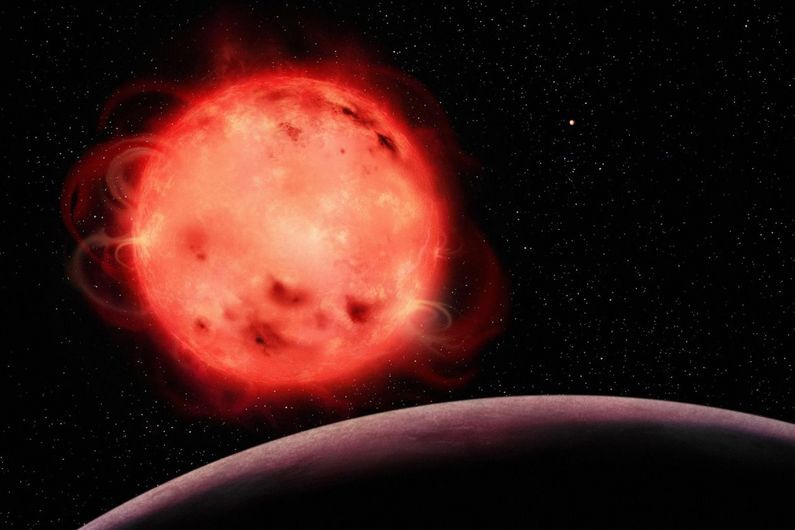
A new study of the intriguing TRAPPIST-1 exoplanetary system has demonstrated the complex interaction between the activity of the system's star and its planetary features.
Astronomers led by a team at Université de Montréal has made important progress in understanding the intriguing TRAPPIST-1 exoplanetary system, which was first discovered in 2016 amid speculation it could someday provide a place for humans to live.
Not only does the new research shed light on the nature of TRAPPIST-1 b, the exoplanet orbiting closest to the system’s star, it has also shown the importance of parent stars when studying exoplanets.
Published in The Astrophysical Journal Letters, the findings by astronomers at UdeM's Trottier Institute for Research on Exoplanets (iREx) and colleagues in Canada, the U.K. and U.S. shed light on the complex interplay between stellar activity and exoplanet characteristics.
Captured the attention
TRAPPIST-1, a star much smaller and cooler than our sun located approximately 40 light-years away from Earth, has captured the attention of scientists and space enthusiasts alike since the discovery of its seven Earth-sized exoplanets seven years ago. These worlds, tightly packed around their star with three of them within its habitable zone, have fueled hopes of finding potentially habitable environments beyond our solar system.
Led by iREx doctoral student Olivia Lim, the researchers employed the powerful James Webb Space Telescope (JWST) to observe TRAPPIST-1 b. Their observations were collected as part of the largest Canadian-led General Observers (GO) program during the JWST’s first year of operations. (This program also included observations of three other planets in the system, TRAPPIST-1 c, g and h.) TRAPPIST-1 b was observed during two transits — the moment when the planet passes in front of its star — using the Canadian-made NIRISS instrument aboard the JWST.
“These are the very first spectroscopic observations of any TRAPPIST-1 planet obtained by the JWST, and we’ve been waiting for them for years" said Lim, the GO program's principal Investigator.
She and her colleagues used the technique of transmission spectroscopy to peer deeper into the distant world. By analysing the central star’s light after it has passed through the exoplanet’s atmosphere during a transit, astronomers can see the unique fingerprint left behind by the molecules and atoms found within that atmosphere.
'Just a small subset'
“This is just a small subset of many more observations of this unique planetary system yet to come and to be analysed,” adds René Doyon, Principal Investigator of the NIRISS instrument and co-author on the study. “These first observations highlight the power of NIRISS and the JWST in general to probe the thin atmospheres around rocky planets.”
The astronomers' key finding was just how significant stellar activity and contamination are when trying to determine the nature of an exoplanet. Stellar contamination refers to the influence of the star's own features, such as dark spots and bright faculae, on the measurements of the exoplanet's atmosphere.
The team found compelling evidence that stellar contamination plays a crucial role in shaping the transmission spectra of TRAPPIST-1 b and, likely, the other planets in the system. The central star’s activity can create “ghost signals” that may fool the observer into thinking they have detected a particular molecule in the exoplanet’s atmosphere.
This result underscores the importance of considering stellar contamination when planning future observations of all exoplanetary systems, the scientists say. This is especially true for systems like TRAPPIST-1, since the system is centred around a red dwarf star which can be particularly active with starspots and frequent flare events.
“In addition to the contamination from stellar spots and faculae, we saw a stellar flare, an unpredictable event during which the star looks brighter for several minutes or hours,” said Lim. “This flare affected our measurement of the amount of light blocked by the planet. Such signatures of stellar activity are difficult to model but we need to account for them to ensure that we interpret the data correctly.”
A range of models explored
Based on their collected JWST observations, Lim and her team explored a range of atmospheric models for TRAPPIST-1 b, examining various possible compositions and scenarios.
They found they could confidently rule out the existence of cloud-free, hydrogen-rich atmospheres - in other words, there appears to be no clear, extended atmosphere around TRAPPIST-1 b. However, the data could not confidently exclude thinner atmospheres, such as those composed of pure water, carbon dioxide, or methane, nor an atmosphere similar to that of Titan, a moon of Saturn and the only moon in the Solar System with its own atmosphere.
These results are generally consistent with previous (photometric, and not spectroscopic) JWST observations of TRAPPIST-1 b with the MIRI instrument. The new study also proves that Canada’s NIRISS instrument is a highly performing, sensitive tool able to probe for atmospheres on Earth-sized exoplanets at impressive levels.
About this study
“Stellar contamination and no evidence for an atmosphere in the JWST/NIRISS transmission spectrum of TRAPPIST-1 b," by Olivia Lim et al, was published Sept. 22, 2023 in Astrophysical Journal Letters. Other researchers involved in the study are from: Université de Montreal's iREx, University of Calgary, University of Oxford, McGill University and Bishop's University, with dditional contributors from the University of Michigan, MIT, Cornell University, and and Johns Hopkins University's Space Telescope Science Institute.
Quelle: Université de Montréal
----
Update: 30.09.2023
.
New JWST images suggest our understanding of the cosmos is flawed
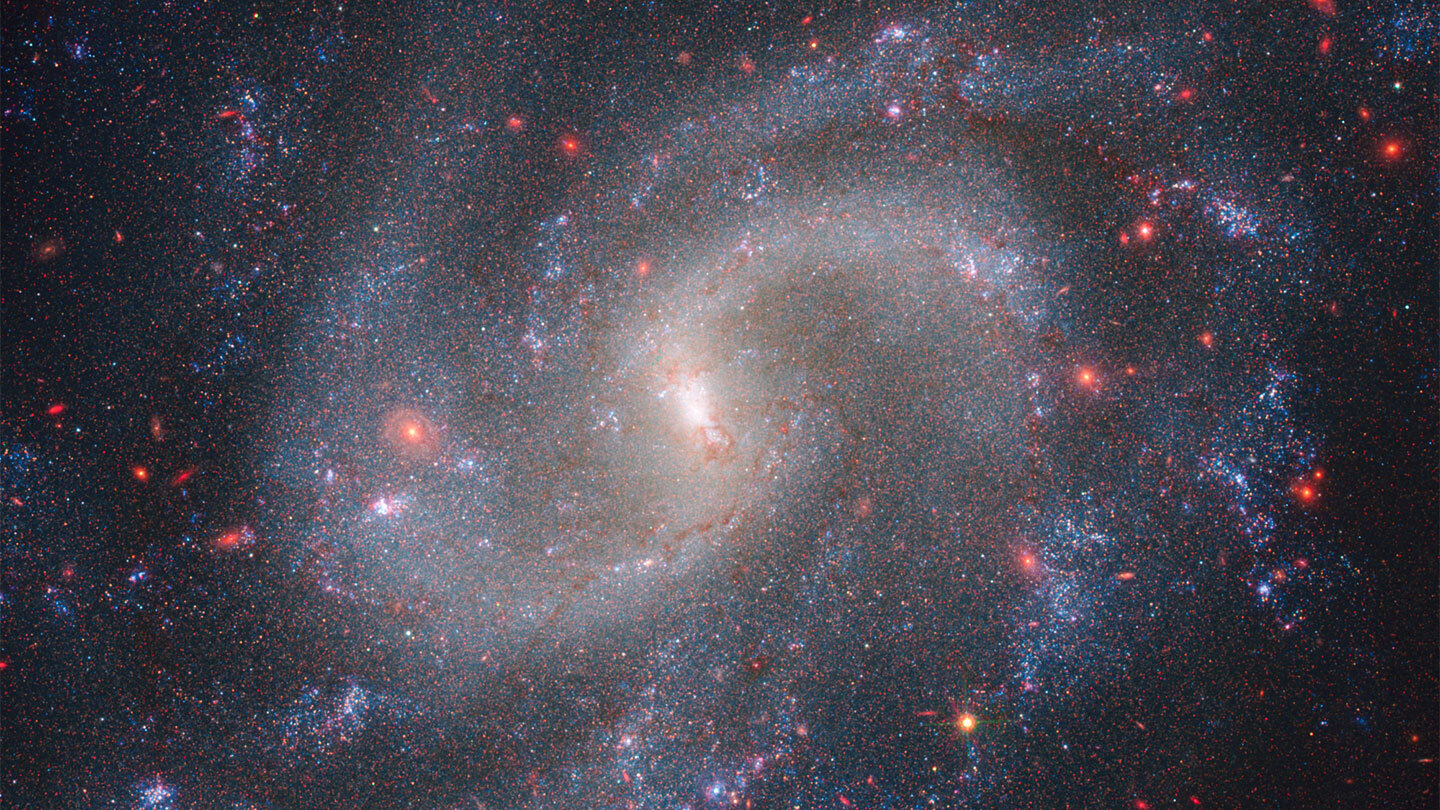
Pulsating stars that reveal the motion of this spiral galaxy 75 million light-years away (called NGC 5584) and other galaxies suggest the universe is expanding faster than astronomers’ leading theory of the universe says it should.
ADAM G. RIESS/JHU, STSCI, NASA, ESA, CSA
The greatest puzzle in cosmology just got even more puzzling.
Images from the James Webb Space Telescope have confirmed that the universe appears to be expanding significantly faster than it should be, researchers report in a study accepted in the Astrophysical Journal. The observation is in conflict with an esteemed theory, the standard model of cosmology, that describes how the universe has evolved since the first moments after the Big Bang.
The conflict comes down to calculations of the Hubble constant, a number that describes how fast everything in the universe is flying apart. One calculation, based on Planck satellite observations of the oldest light in the universe in conjunction with the standard model of cosmology, suggests the Hubble constant is 67.4 kilometers per second per megaparsec (a megaparsec is about 3 million light-years). Hubble Space Telescope images of stars at various distances from us provide a fundamentally incompatible value — 73 kilometers per second per megaparsec.
The discrepancy is known as the Hubble tension, and new JWST data hasn’t done anything to ease it (SN: 7/30/19). The telescope took images of the same stars as the Hubble telescope and calculated a very similar Hubble constant. Although the Planck number disagrees from the Hubble telescope and JWST number by less than 10 percent, the discrepancy in the measurements implies that there’s something terribly wrong with our understanding of the universe. Unless an error turns up in one of the measurements, it will take strange new physics to explain the tension.
“Papers in the literature over the last 10 years have invoked anything from weird dark matter to weird dark energy, to another [exotic] particle, to a magnetic field in the early universe to a new field, all kinds of things” to explain the Hubble tension, says cosmologist Adam Riess of Johns Hopkins University.
Some of these explanations “look semi-successful, some of them look like failures, some of them would cause other problems,” he says. Developing a theory that might resolve the tension “is still very much in the skunkworks [or extremely speculative] stage of trying to understand what [the tension] could mean.”
JWST looks to the stars to calculate the Hubble constant
With the Hubble telescope and JWST, astronomers calculate the Hubble constant by observing flashing stars known as Cepheid variables. The stars flare up periodically at rates that indicate how much light they’re putting out. Comparing a star’s brightness in telescope images with its expected brightness, based on the flare-up rates, gives a measure of the distance to the stars. Shifts in the color of the light coming from the stars reveal how fast they’re moving. Combining distance and speed observations of Cepheid stars leads to a measure of the expansion of the universe.
But Cepheid variable stars tend to sit deep inside galaxies, surrounded by crowds of other stars. That can make it difficult to get good measurements of the Cepheids’ speeds and locations. One simple resolution for the Hubble tension could have been that the Hubble telescope measurements were simply off.
Enter JWST, which can peer through the stellar crowds to clearly make out the color and brightness of Cepheid variables. The higher-resolution JWST images provide data with dramatically lower uncertainties and reduced confusion with nearby stars than the Hubble telescope could manage. The result: The Hubble telescope measurements have been right all along, Riess and colleagues report in their new paper.
This study alone isn’t enough to convince astronomer Wendy Freedman of the University of Chicago. The two galaxies studied are comparatively close to us, on cosmic scales, with the farthest one about 75 million light-years away, she notes. The relative proximity makes it easier to pick out the Cepheids from the stellar crowds. Freedman suspects it will be harder to distinguish Cepheids from the crowds of surrounding stars in more distant galaxies, even with JWST.
“The problem is only going to be worse,” Freedman says. “Because the resolution, it gets worse as you go to a higher distance.” For very distant galaxies, she suspects, stars could appear too close together to pick out the Cepheids from neighboring stars, even for JWST. As a result, Freedman says that Riess’ confirmation of the higher Hubble constant may crumble with analysis of more distant Cepheids.
JWST’s images leave the Hubble tension untouched
Hints that the measurements might hold up at larger distances arose in a Sept. 12 presentation at a conference in Baltimore dedicated to the first year of JWST science. Riess showed preliminary Cepheid data from four more galaxies. One of them is 140 million light-years away — among the most distant galaxies in the Hubble telescope Cepheid studies. JWST data from those stars also line up with the Hubble telescope measurements. Although still awaiting peer review, the images strongly suggest that the JWST has indeed overcome the uncertainties that resulted when light from Cepheids got mixed up with light from nearby stars in the lower resolution Hubble telescope images.
University of Cambridge astrophysicist George Efstathiou, who was not involved in the study, is both convinced that Riess has gotten the measurements right and confounded by the implications. “When they showed me all of that [data],” Efstathiou says, “my reaction was, ‘Well, you know, I’m stumped.’”
Efstathiou is a member of the Planck satellite collaboration, which studied the oldest light in the universe, called the cosmic microwave background, and found the lower value for the expansion of the universe. The satellite’s calculation is based on images of the patterns in light from the early universe. Together with the standard model of cosmology, the images show that the universe is expanding with a Hubble constant that’s lower than the JWST measurement by about 5.6 kilometers per second per megaparsec.
As it stands, there doesn’t seem to be anything wrong with the Planck measurement of the Hubble constant or with the JWST observations. The tension between the measurements points a finger at the standard model of cosmology as the problem. But the standard model also appears to be unimpeachable; it’s withstood numerous other challenges without breaking down. The model came about in part due to the discovery of the accelerating expansion of the universe, which earned Riess and others a Nobel Prize in physics (SN: 10/4/11). The revelation was a key piece in shaping the model to include dark matter, dark energy and other factors, making it the simplest theory that can accurately describe the universe.
Now, though, Riess’ Cepheid-based studies of the Hubble constant show that there’s still more to learn.
“This is a crack, or a surprise that doesn’t fit,” Riess says. “It’s left us more in a kind of confused or purgatory state.” The implication, he says, is “there’s a problem with the standard model. You can revise it, but we don’t know how to revise it, which direction or in what way.”
People shouldn’t mistake the tension over the Hubble tension as despair. “It’s more of an opportunity to learn something about the universe with these telescopes,” Riess says.
One possibility is completely new physics.
“If there’s new physics, that’d be fun,” Freedman says. “We’d all like to see something new and interesting…. Either way, I think it’s going to be an exciting result — either confirming the [standard] model or showing that there’s something still in the model that’s missing.”
Quelle: ScienceNews
----
Update: 4.10.2023
.
Supernova in James Webb Space Telescope image could help solve one of the universe's biggest mysteries
NASA's James Webb Space Telescope has spotted a distant supernova that appears three times in the same photo.

The distant supernova "H0pe" can be seen three times (labeled SN2a, SN2b and SN2c) in the orange arc of light surrounding a galaxy cluster on the left side of this James Webb Space Telescope image. Other gravitationally-lensed objects are also labeled in this image. (Image credit: B. Frye et al., ApJ submitted, 2023)
A rare, warped supernova that appears three times in a single image could help researchers finally solve a long-standing inconsistency about the universe that has threatened to unravel our understanding of the cosmos, one expert claims.
The type 1a supernova, named SN H0pe, was first discovered lurking in photographs captured by NASA's James Webb Space Telescope (JWST) in March. In these images, the exploding star can be seen as an arc of orange light with three bright points that surround part of the galaxy cluster PLCK G165.7+67.0 (G165), which is around 4.5 billion light-years from Earth.
The light arc is the result of gravitational lensing — an effect caused when light from a distant object, such as a supernova, passes through space-time that has been warped by the gravity of a massive foreground object, like a large galaxy, that is positioned directly between the distant object and the observer. This also magnifies the distant object, making it easier for researchers to analyze.
The three bright spots in the arc around G165 make it seem like there are three separate light sources being visually manipulated, or lensed by the foreground galaxy. But in reality, the supernova, which is located around 16 billion light-years from us, has been duplicated twice by the lensing effect.
In a new article published on BigThink.com on Sept. 20, astrophysicist and science communicator Ethan Siegel, who was not involved in the study, wrote that SN H0pe could help solve a longstanding inconsistency about the expansion of the universe — the "Hubble tension."
The Hubble tension is based on a discrepancy between the two main ways of estimating the rate of the universe's expansion, known as the Hubble constant. The first method, which involves measuring expansion using the cosmic microwave background (CMB) — leftover radiation from the Big Bang that was first detected in 1964 — comes out with one value for the Hubble constant. But the second method, which involves measuring how far specific objects, such as galaxies and supernovas, are moving away from us, consistently comes out with a slightly higher value.
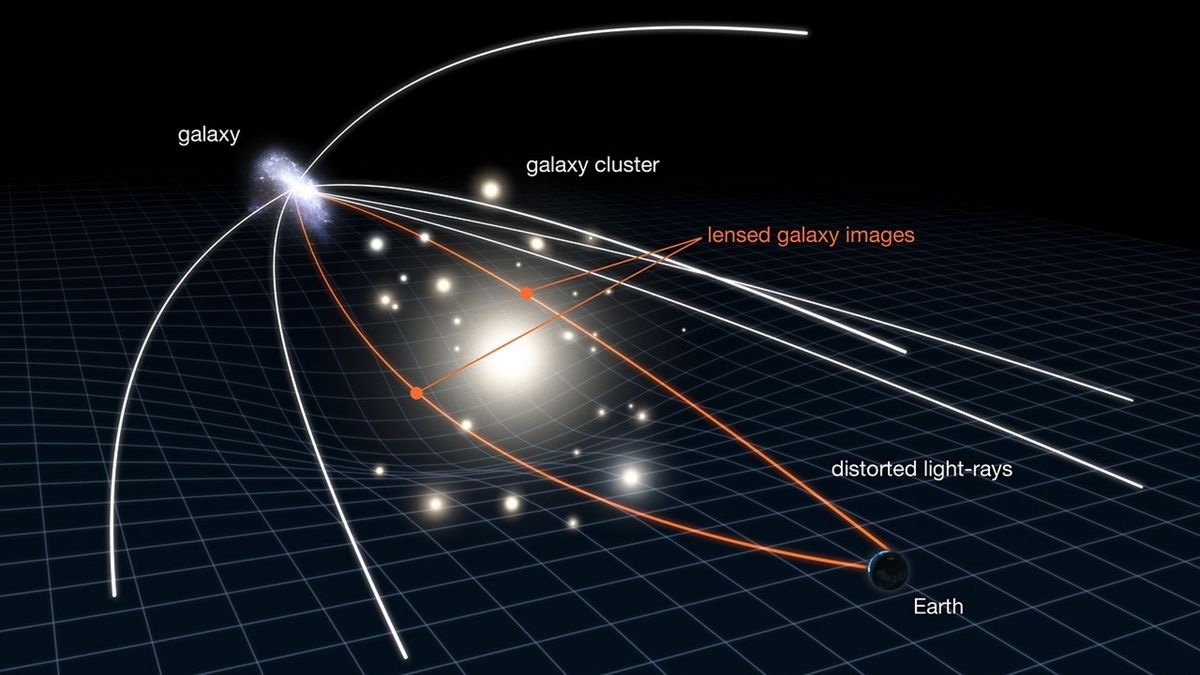
A diagram that shows how gravitational lensing works. In this example, the light of a galaxy travels through curved space-time surrounding a galaxy cluster. (Image credit: NASA, ESA & L. Calçada)
This problem has confused scientists for decades because there is no clear reason why one method should produce a different result from the other, Siegel wrote. The conundrum has even caused some researchers to declare it a crisis in cosmology.
SN H0pe could help solve the Hubble tension because it is a type 1a supernova, which astronomers refer to as a "standard candle" — an incredibly reliable reference point from which we can measure the universe's expansion, Siegel wrote.
Type 1a supernovas involve a white dwarf star stealing matter from a binary partner star, before reaching critical mass and exploding. These bright explosions all have near-equal initial luminosity and dim over time at the same rate. By comparing these standard candles at various distances from Earth, scientists can work out exactly how fast they are moving away from us and can then deduce the expansion rate of the universe.
SN H0pe is a particularly important standard candle because it is the second most distant type 1a supernova ever detected, Siegel wrote. The strong gravitational lensing and duplication in the new images also give researchers more information to work with than normal, he added.
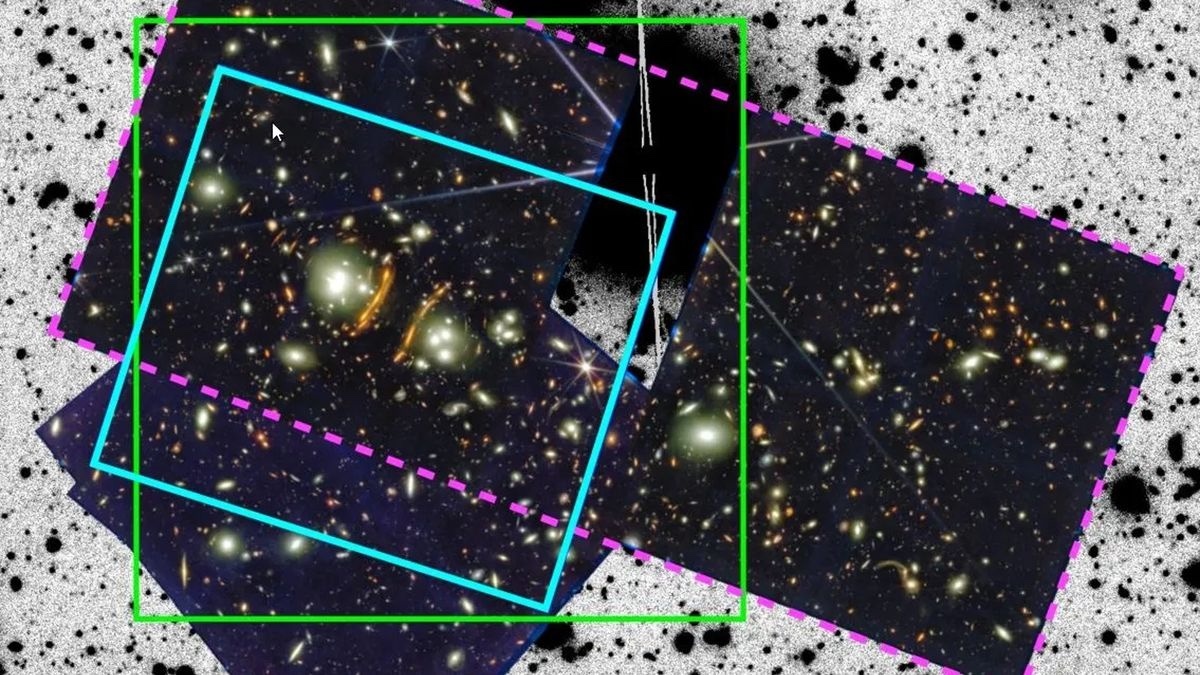
A zoomed out view of the gravitationally-lensed supernova and surrounding galaxy cluster. (Image credit: NASA/James Webb Space Telescope/Frye et al.)
The idea of using duplicated supernovae to tackle the problem of Hubble tension is not new. In May, scientists used data from a reappearing, quadruple-lensed supernova named Refsdal to calculate a new value for the Hubble constant. Although this still differed from the value calculated using the CMB, the difference between the two was reduced, suggesting that they could one day match up.
It is currently unclear whether SN H0pe can be used to calculate an even more reliable value for the Hubble constant. But researchers are confident that if JWST's keen eye can continue to pick out more distant standard candles, the problem of Hubble tension may finally be solved.
Quelle: SC









